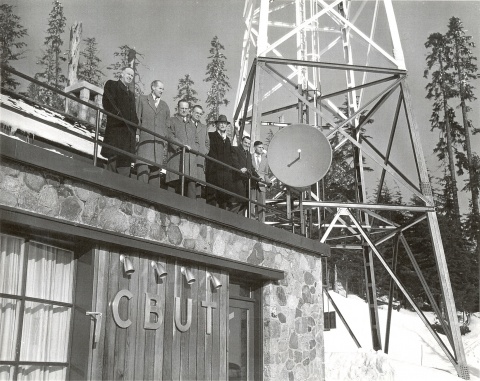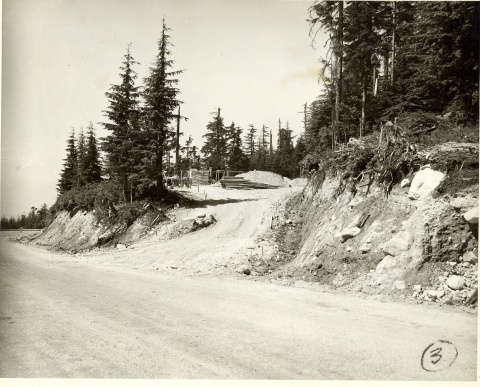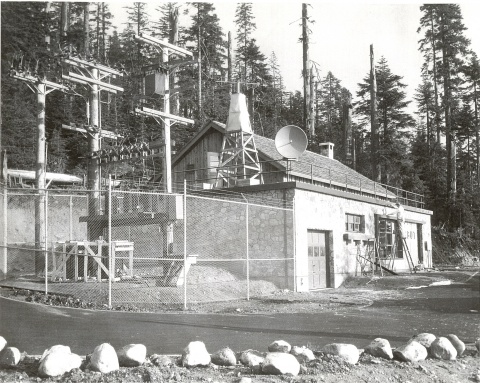Milestone-Nomination:First television broadcast in Western Canada
Docket Number: 2009-10
Proposal Link: https://ethw.org/Milestone-Proposal:First_television_broadcast_in_Western_Canada
Proposed Citation
First television broadcast in Western Canada, 1953
On 16 December 1953, the first television broadcast in Western Canada was transmitted from this site by the Canadian Broadcasting Corporation's CBUT Channel 2. The engineering experience gained here was instrumental in the subsequent establishment of the more than one thousand public and private television broadcasting sites that serve Western Canada today.
We propose to mount the plaque on a wall near the main gate of the CBC Broadcasting Site on Mount Seymour. CBC conducts frequent tours for students and the public. All tours include a stop at this location.
The site is located on the south slope of Mount Seymour, just below the Mount Seymour Ski Area. It is owned by the Canadian Broadcasting Corporation. The geodetic coordinates of the site are Lat: 49°21′13″N, Lon: 122°57′24″W.
Historical Photographs
The following historical photographs were provided by Dave Newbury, Senior Manager - West, CBC Transmission, Vancouver.

The original transmitter building burned to the ground a number of years ago and was rebuilt. The original garage, parts of the kitchen area and the original stone work from the original building were saved and are still apparent.
Historic significance of this work: its importance to the evolution of electrical and computer engineering and science and its importance to regional/national/international development.
The CBUT broadcasting site on Mount Seymour (North Vancouver, British Columbia) was both the first television broadcasting site in Western Canada and the first high elevation/mountain top broadcasting site in Canada. The opening broadcast featured special launch ceremonies at 6 pm and was followed by a CBC newscast at 7 pm.
(Western Canada refers to the four provinces west of the Great Lakes: British Columbia, Alberta, Saskatchewan and Manitoba. It is physically separated from Central Canada (Ontario and Quebec) by the Great Lakes and the relatively inhospitable Canadian Shield.)
The historical context of the CBUT broadcasting site on Mount Seymour has been documented in
Broadcasting in Canada: History and Development of the National System, CBC, 1962, 92 pp.
and
A Brief History of the Canadian Broadcasting Corporation, CBC, 1976, 40 pp.
At the time of the first broadcast, the establishment of a television station in Vancouver was seen as an important contribution to Canadian sovereignty and cultural identity. The first broadcast and associated ceremonies were major events, as documented in
"CBC Chief in City", 15 December 1953. Television Transmitter, Mount Seymour Docket 1, Vancouver City Archives.
and
Anne Kloppenborg, Ed., Vancouver's first century : a city album 1860-1960, Vancouver : J.J. Douglas, 1977.
CBUT provided an important training ground for and contributed to the principles and practices that guided the engineers who went on to deploy the over 1000 public and private broadcasting sites that serve Western Canada today, as related by
Dave Newbury, Senior Manager - West, CBC Transmission, Vancouver. (Dave has been a CBC employee for 40 years. He knew many of the engineers and technicians who worked at the CBC Broadcast Site when it began operation and is very familiar with the CBC transmitting sites in Western Canada.)
Although VHF transmitting sites had already been established in Western Canada for FM broadcasting, these sites were generally located atop tall buildings in urban areas, e.g., VE9FG (later CBU-FM), a 1-kW FM broadcast station that became operational on 21 November 1947 and which was located at the Hotel Vancouver in downtown Vancouver as documented at
Canadian Communications Foundation (Official site) at http://www.broadcasting-history.ca .
The three television broadcasting sites that had been established in Canada previously (in Montreal, Toronto and Ottawa) were also installed at relatively low elevations. For the CBC managers of the day, establishing the network’s fourth television transmitter so far West and at a high elevation and a remote location was a bold and significant decision.
The quality of the initial site selection and engineering is underscored by the longevity of the CBC Broadcasting Site on Mount Seymour and the large number of other television and FM broadcast transmitters that are installed in the same general area today, including:
FM stations
CBU-1-FM 88.1 (CBC Radio One)
CBUX-FM 90.9 (Espace Musique)
CKYE-FM 93.1 (Red FM)
CJJR-FM 93.7 (JR-FM)
CFBT-FM 94.5 (The Beat 94.5)
CKZZ-FM 95.3 (Virgin Radio 95.3)
CHKG-FM 96.1 (Fairchild Radio)
CKLG-FM 96.9 (Jack FM)
CBUF-FM 97.7 (Première Chaîne)
CFOX-FM 99.3 (99.3 The Fox)
CFMI-FM 101.1 (Rock 101)
CFRO-FM 102.7 (Co-Op Radio)
CHQM-FM 103.5 (103.5 QM/FM)
CFUN-FM-2 104.9 (104.9 Fun FM)
CBU-FM 105.7 (CBC Radio 2)
CKAV-FM-2 106.3 (Aboriginal Voices Radio)
TV stations
CBUT-TV (CBC): VHF 2 (NTSC), UHF 58 (ATSC)
CHAN-TV (Global): VHF 8 (NTSC) UHF 22 (ATSC)
CIVI-TV-2 (rebroadcaster of CIVI-TV, A): UHF 17 (NTSC)
CBUFT-TV (Radio-Canada): UHF 26 (ATSC)
CIVT-TV (CTV): UHF 32 (NTSC), UHF 33 (ATSC)
CHNM-TV (OMNI): UHF 42 (NTSC)
Preservation of the Historical Record
Unlike scientific research, broadcasting is primarily a business undertaking and the companies involved have not seen fit to devote much effort to preserving the historical record. For example, the CBC disposed of much of the original documentation concerning early television broadcasting when the project group in Montreal moved to new offices some 20 years ago.
In 1967, the Canadian Association of Broadcasters established The Canadian Communications Foundation with a mandate to "commemorate throughout Canada the development of electronic communications". The Foundation was largely dormant until a group of retired senior broadcasting executives led by Ross McCreath, Lyman Potts and Peter Searle revived the organization during the 1990's. Their efforts to document the history of broadcasting in Canada resulted in the development of their official website at
The Canadian Communications Foundation, http://broadcasting-history.ca .
While some written records still exist, the CCF has been forced (as have we) to rely on interviews with senior and retired members of the broadcasting community to fill in the details regarding the history of broadcasting in Canada.
In October 2009, we contacted Pip Wedge, Vice-President, Canadian Communications Foundation, regarding our efforts to prepare this nomination. He replied
If you think the involvement of CCF can in any way help you achieve your objectives, then of course I'll be happy to co-operate. As I've said, we don't have any historic information on CBUT beyond what is already on our site, but I'll wait to hear what you have in mind.
If the nomination is successful, we will invite CCF to help publicize it via their website and possibly to participate in the dedication ceremony.
Distinguishing features or characteristics of this work
As related above, only three television broadcast stations had been established in Canada prior to CBUT in Vancouver; all were located in Eastern Canada and all were installed at relatively low elevations. For the CBC managers of the day, establishing the network’s fourth television transmitter so far West, at a high elevation and at a remote location was a bold and significant decision.
The relatively complicated topography of the Lower Mainland of British Columbia required that considerable care be taken to choose a broadcasting site that would provide the best coverage. Predicting and evaluating the coverage of a VHF broadcast transmitter in mountainous terrain is much different from the corresponding task for the MF broadcast transmitters that had been installed at various low-level locations throughout the Lower Mainland during the 1930‘s and 1940‘s.
This nomination was prepared by:
Prof. Dave Michelson, University of British Columbia, davem@ece.ubc.ca, and
Dave Newbury, Senior Manager - West, CBC Transmission, Dave.Newbury@cbc.ca
Please attach a letter in English, or with English translation, from the site owner giving permission to place IEEE milestone plaque on the property.
IEEE_Milestone_CBC.pdf
Mt_Seymour_01.jpg
Mt_Seymour_02.jpg
Mt_Seymour_03.jpg
Mt_Seymour_Region_Senior_Staff.jpg



